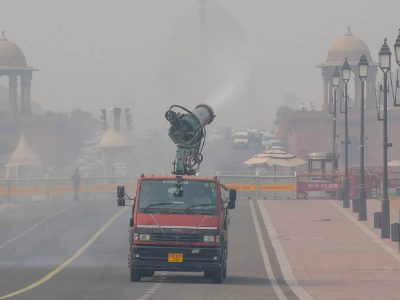Friday afternoon isn’t generally a time when you expect children to file in numbers in a hospital. It is a day when kids return from school and relax ahead of the weekend.
But the scene at the Dr Shroff’s Charity Eye Hospital, a 95-year-old eye treatment centre located in Daryaganj, belied expectations. The kids’ section of the hospital was full of patients.
“We get as many as 50 child patients a day which used to be the number in one week prior to Covid-19. We are experiencing an alarming spike of 700% in cases of myopia which is a worrying sign,” said Dr Munesh Chandra Bhati, who is in charge of the myopia department at the hospital.
Myopia is an eye condition in which the patients can see the items near them clearly, such as words on a page. However, their distant vision is fuzzy, and glasses or contact lenses are most likely required for activities such as seeing the blackboard clearly, cycling, driving or identifying people down the block.
“The main reason for the rising number of cases of near-sightedness is the excessive use of gadgets and increased screen time, as well as the constant decrease in outdoor activities and sunlight consumption,” he added.
“When we look at something close to us, our eyes have to work harder. Human eyes are designed to see distances, but what has happened here is that people are constantly glued to screens, which requires constant efforts on the part of the human eyes, which become accustomed to that particular power. Then when people are required to look at a distance, they realise that the eyesight level has decreased, resulting in near-sightedness.”
Troublesome signs
He goes on to explain that the pandemic has aggravated matters as children’s school lessons and assignments shifted online. Children’s daily routines were severely disrupted by Covid-19 since schools and extracurricular activities were shut down. The pandemic restrictions decreased kids’ already limited opportunities to play outside, which had an adverse impact on both their physical and emotional health.
“There was already a constant consumption of content but things worsened during the pandemic when kids were not allowed to go out. That is damaging to children, particularly those in the early phases of motor development,” he added.
“However, we must keep in mind that, during the pandemic, the majority of children were not properly vaccinated, and that left their bodies vulnerable to such problems at a young age. There were not as many cases of this on a regular basis prior to the pandemic,” Bhati added further.
“First, we counsel the patients to assess the problem and if it can be avoided by practicing medications — mostly eye-drops, eye-glasses and diet enrichment which is all we need in most circumstances,” said Bhati.
“However, certain cases demand special attention.”
In those special circumstances, the doctor explained, the patient’s eyeball continues to grow in size, depreciating the retina and causing complications like spots in the retina and retinal detachment.
“Overall, as the power need of eyesight grows, the condition of the retina deteriorates, which can occasionally lead to permanent blindness. So, controlling that is the primary goal of myopia therapy,” he explains before concluding, “It is just the outcome of too much work from a very close distance and screen time.”
More serious problems
Dr Neera Aggarwal, who has been a refractive and cornea surgeon in Delhi since 1994, and is one of the pioneers in the field warned about the lazy eye problem.
“If not treated timely it can cause lazy eye (amblyopia). It is a condition in which one eye has impaired vision due to faulty visual development throughout childhood. The weaker or more sluggish eye frequently travels inside or outward. Amblyopia often occurs between the ages of one and seven years,” she said.
Common reasons, she explains, are asymmetry in the muscles of the eyes.
“This imbalance might lead the eyes to cross in or turn out, making it difficult for them to operate together. A considerable discrepancy in prescriptions in each eye, which is frequently related to far-sightedness but can also be due to near-sightedness or an uneven surface curvature of the eye (astigmatism) and an issue with one eye, such as a hazy region in the lens (cataract), might prevent that eye from seeing well. Deprivation amblyopia in infancy needs immediate treatment to avoid irreversible visual loss. It is frequently the most severe kind of amblyopia,” she added.
“It is the major cause of loss of eyesight during childhood. Lazy eyes seldom affect both eyes. Early detection and treatment can help avoid long-term eye issues in your child. Typically, the eye with impaired vision may be repaired using glasses, contact lenses or patching therapy,” she explained further.
Lifestyle is a major reason
An official at the Capital’s Guru Teg Bahadur Hospital said on condition of anonymity that children are facing a variety of problems.
“The situation is quite bad, especially among the younger generation. It’s not just myopia. Children are facing respiratory issues, cold fever and nutritional problems. These problems are on the rise and must be thoroughly investigated and adapted and prevented accordingly,” said an official.
Child specialist Gorika Bansal also blamed online classes as well as children being glued constantly to the screens as being a reason for declining vision among kids.
“Myopia is on the rise because children these days are required to be glued to screens. Earlier, this wasn’t the case. Now there are online classes and smart projectors, and the flow of harmful rays constantly also adds up to worsening the situation which wasn’t the case a few years ago. In offline classes, you had to look up at the blackboard from a distance. Your eyesight was not pressurised this much,” she said.
She blamed the lifestyle that is being passed on to the younger ones like working on laptops for several hours, and handing over the phone to children just so that they stay occupied.
“Even books have become digital these days—all of these seemingly innocuous activities expose our eyes to dangerous blue light, which is why now almost every other child nowadays is required to wear eyeglasses or lenses,” added Gorika.
Preventive measures
According to Dr Munesh Chandra Bhati and Dr Neera Agarwal, there are various preventive measures one can take to stop decline in eyesight.
- Physical activities should be made a regular component of the life of children, especially during their growing years. Around two hours of outdoor activities is compulsory and studies have shown that it is quite beneficial especially in the winters.
- Meditation is something that youngsters should experiment with.
- Restricting screen time is one of the most crucial things, and parents must ensure that. Children learn from what they see, so in order to instill such changes in their children, parents must also follow suit. You can’t use gadgets in front of kids and then warn them against using them.
- Eat a diet that consists of a lot of leafy greens, fruits and nuts.
- Take a break. If you’ve been staring at screen for more than 20 minutes, take a 20-second break.
- Try not to sit too close to the screens. Keep at least an arm’s length between you and the screen.
Follow us on:
Instagram: instagram.com/thepatriot_in/
Twitter: twitter.com/Patriot_Delhi
Facebook: facebook.com/Thepatriotnewsindia





